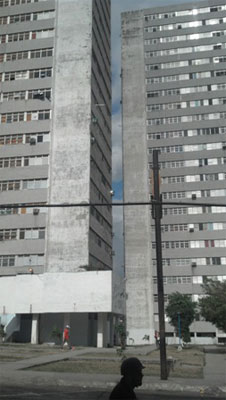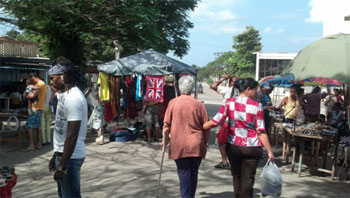Keeping Up with Fads in Cuba
The Return of the Mameys
Graham Sowa
 HAVANA TIMES — The British Flag fad started sometimes late last year. Now the Union Jack is part of the Havana landscape, adorning everything from human bodies to car antennas. After a 250 year absence the British have returned to Cuba.
HAVANA TIMES — The British Flag fad started sometimes late last year. Now the Union Jack is part of the Havana landscape, adorning everything from human bodies to car antennas. After a 250 year absence the British have returned to Cuba.
In 1762 the British won the Battle of Havana after a months’ long siege of the now tourist filled Morro Castle on the eastern side of the entrance to the bay. The British troops filled the Capital.
Legend has it that the Cubans called their new imperial overlords the mameys, after the tropical fruit whose meat has a rich red color like the uniforms of the British soldiers.
However just like the fruit, the English occupation of the most valued Spanish harbor in the New World was seasonal. The Spaniards were back in power a few months later after the Treaty of Paris ended a few international imperial conflicts by reshuffling colonized land around the globe.
The British legacy was all but forgotten except for history books and the odd Anglo street name (such as O’Reilly Street in Old Havana).
But this year there has been a reemergence of the Union Jack. I started noticing it on t-shirts and the pockets of jeans and skirts in December, not paying much attention. Then when I came back to Cuba in January it was everywhere.
I’ve seen the flag adorned clothing of all styles, painted fingernails, British flag hair style with corresponding dye, bags, and even shoes. I’m left to imagine that some people have even taken the theme to their underwear.
A fellow norteamericano told me the fad was a result of Cuba buying up a bunch of clothing leftovers from the Summer Olympic Games that took place in London.
At first I bought into this explanation. International events usually produce an overabundance of merchandise that finds its way to the developing world. This is the fate of all over-sized and event specific clothing no one wants in the first world.
I ran this hypothesis by some of my Cuban friends. They were not in agreement. Their explanation was the people thought it was cool that London put on the Olympic Games and the British flag fad was a result of a newfound affinity for all things Anglo.
I find my Cuban friend’s explanation more likely. The flag is present in too many places in the city and with such a diversity of expression to only be the result of a few Olympic leftovers.
I think part of the explanation of the fad also involves the cuentapropistas. The past couple of years have seen the conversion of numerous patios and front porches on the main streets of Havana into private shops. The most common goods sold are entertainment music and movies (pornography is officially illegal but most have it if you ask), household cleaning and repair items, and clothing.
 Now no clothing store is complete without at least a minor selection of British Flag t-shirts, shoes, and purses. Earrings, stickers, key chains, car decals are common as well.
Now no clothing store is complete without at least a minor selection of British Flag t-shirts, shoes, and purses. Earrings, stickers, key chains, car decals are common as well.
Many of these items are locally designed and made. One of my favorite local designs is a mix of the British flag and another popular theme on the streets of Havana: the cartoon character Sponge Bob (who is a constant reminder of the many reasons why I think the United States is culturally handicapped).
The other day I saw a Sponge Bob t-shirt with a British flag background. Sponge Bob was smoking a giant doobie. I think there was a marijuana leaf on the shirt as well. While none of those individual themes are uniquely Cuban the mix of them on the same T-shirt certainly is.
I mean, why spend money to buy one shirt promoting pot, another with a psychotic cartoon sponge, and another with a flag of your previous imperial masters when you can get all of that in just one purchase. If Cuba has taught me anything it is how to economize.
I imagine the British flag fad will follow the rule of exponential growth and soon disappear from the shops of the cuentapropistas. I don’t know any state-run shops that carry British flag items and I doubt they are dynamic enough to keep up with fads.
I was keeping an eye out the other day as I strolled Obispo Street and only saw the familiar and uninteresting Che and Cuba flag themes. The tourists are not really catching on either.
Like the fruit and the original British occupation of Havana the return of the mameys is not bound to stay around all year. But the presence of dynamic fads in Cuba opens the door to at least two thoughts in my mind: either communism isn’t static and homogeneous or Cuba isn’t communist.

Ah…. the homogeneous communist Cuban capitalist. The wick is burning at both ends. All in a days work in human-kinds experiment. Sounds to me like a progressive hybrid. Talleyho ol’ chum
O’Reilly has nothing to do with the British. The name of the street it’s in honor of Alejandro (Alexander) O’Reilly, an Irish mercenary that fought for Spain and end up a count during the reign of Carlos III. You can see it here: http://es.wikipedia.org/wiki/Alejandro_O%27Reilly
The answer is Cuba isn’t communist. No one is (or has been). Communism has never been more than mental masturbation played out on a national level. Kind of sounds good, feels really good for a little while, and always leaves a mess. By the way, Jazz and Hip-hop are both American originals. Both have come to dominance around the world and speak to a culture in ways no other music style could. Your comment accusing American culture of being handicapped is not without exceptions.